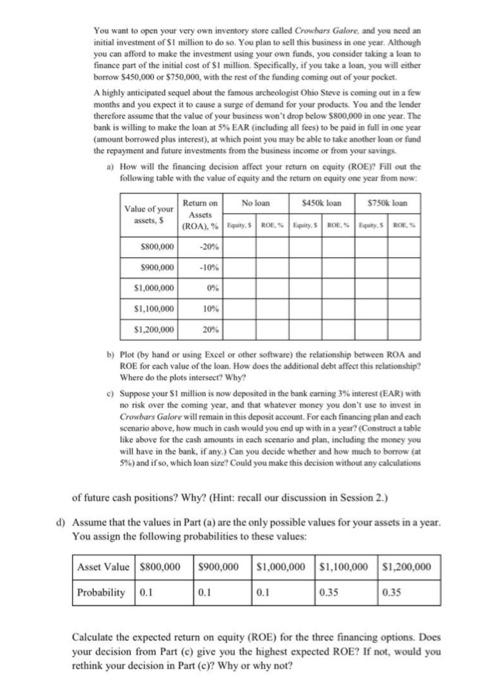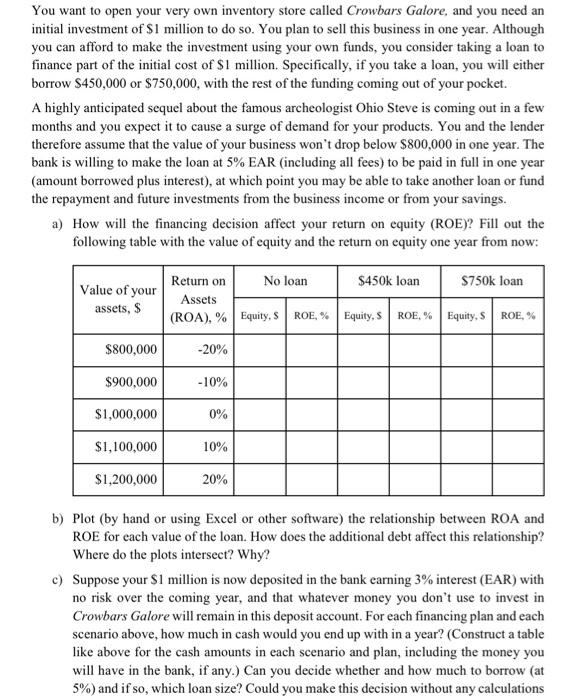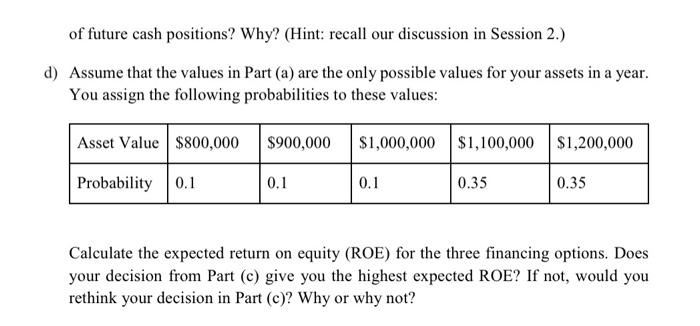You want to open your very own inventory store called Crowbars Galore, and you need an initial investment of St million to do so. You plan to sell this business in one yeat. Although you can afford to make the investment using your own funds, you consider taking a loan to finance part of the initial cost of $1 million Specifically, if you take a loan, you will either borrow $450,000 or 5750,000, with the rest of the funding coming out of your pocket. A highly anticipated sequel about the famous archeologist Ohio Steve is coming out in a few months and you expect it to cause a surge of demand for your products. You and the lender therefore assume that the value of your business won't drop below $800,000 in one year. The bank is willing to make the loan at 3% EAR (including all fees) to be paid in full in one year (umount borrowed plus interest), which point you may be able to take another loon or fund the repayment and future investments from the business income or from your saving # How will the financing decision affect your return on equity (ROEP Fill out the following table with the value of equity and the retum en equity one year from new Return on No loan $450k loan Value of your $750k Loan Assets assets, (ROA) ROUSSES S800,000 $900,000 -10 $1,000,000 09 S1,100,000 109 $1,200,000 2009 b) Plot (by hand or using Excel or other software) the relationnhip between ROA and ROE for each value of the loan. How does the additional debt affect this relationship? Where do the plots intersect? Why? C) Suppose your St million is now deposited in the bunk carning interest (SAR) with no risk over the coming year, and that whatever money you don't use to invest in Crowbars Galore will remain in this deposit account. For each financing plan and each scenario above, how much in cash would you end up within a year?(Constructable like above for the cash amounts in each scenario and plan, including the money you will have in the bank. if any) Can you decide whether and how much to borrow at 596) and if so, which loan sine Could you make this decision without any calculations of future cash positions? Why? (Hint: recall our discussion in Session 2.) d) Assume that the values in Part (a) are the only possible values for your assets in a year You assign the following probabilities to these values: Asset Value $800,000 $900,000 $1,000,000 $1,100,000 $1,200,000 Probability 0.1 0.1 0.35 0.1 0.35 Calculate the expected return on equity (ROE) for the three financing options. Does your decision from Part (c) give you the highest expected ROE? If not, would you rethink your decision in Part (e)? Why or why not? You want to open your very own inventory store called Crowbars Galore, and you need an initial investment of $1 million to do so. You plan to sell this business in one year. Although you can afford to make the investment using your own funds, you consider taking a loan to finance part of the initial cost of $1 million. Specifically, if you take a loan, you will either borrow $450,000 or $750,000, with the rest of the funding coming out of your pocket. A highly anticipated sequel about the famous archeologist Ohio Steve is coming out in a few months and you expect it to cause a surge of demand for your products. You and the lender therefore assume that the value of your business won't drop below $800,000 in one year. The bank is willing to make the loan at 5% EAR (including all fees) to be paid in full in one year (amount borrowed plus interest), at which point you may be able to take another loan or fund the repayment and future investments from the business income or from your savings. a) How will the financing decision affect your return on equity (ROE)? Fill out the following table with the value of equity and the return on equity one year from now: $750k loan Value of your assets, $ Return on No loan $450k loan Assets (ROA), % Equity, SROE%Equity, S ROE% Equity, $ ROE, % $800,000 -20% $900,000 -10% $1,000,000 0% $1,100,000 10% $1,200,000 20% b) Plot (by hand or using Excel or other software) the relationship between ROA and ROE for each value of the loan. How does the additional debt affect this relationship? Where do the plots intersect? Why? c) Suppose your $1 million is now deposited in the bank earning 3% interest (EAR) with no risk over the coming year, and that whatever money you don't use to invest in Crowbars Galore will remain in this deposit account. For each financing plan and each scenario above, how much in cash would you end up with in a year? (Construct a table like above for the cash amounts in each scenario and plan, including the money you will have in the bank, if any.) Can you decide whether and how much to borrow (at 5%) and if so, which loan size? Could you make this decision without any calculations of future cash positions? Why? (Hint: recall our discussion in Session 2.) d) Assume that the values in Part (a) are the only possible values for your assets in a year. You assign the following probabilities to these values: Asset Value $800,000 $900,000 $1,000,000 $1,100,000 $1,200,000 Probability 0.1 0.1 0.1 0.35 0.35 Calculate the expected return on equity (ROE) for the three financing options. Does your decision from Part (c) give you the highest expected ROE? If not, would you rethink your decision in Part (c)? Why or why not? You want to open your very own inventory store called Crowbars Galore, and you need an initial investment of St million to do so. You plan to sell this business in one yeat. Although you can afford to make the investment using your own funds, you consider taking a loan to finance part of the initial cost of $1 million Specifically, if you take a loan, you will either borrow $450,000 or 5750,000, with the rest of the funding coming out of your pocket. A highly anticipated sequel about the famous archeologist Ohio Steve is coming out in a few months and you expect it to cause a surge of demand for your products. You and the lender therefore assume that the value of your business won't drop below $800,000 in one year. The bank is willing to make the loan at 3% EAR (including all fees) to be paid in full in one year (umount borrowed plus interest), which point you may be able to take another loon or fund the repayment and future investments from the business income or from your saving # How will the financing decision affect your return on equity (ROEP Fill out the following table with the value of equity and the retum en equity one year from new Return on No loan $450k loan Value of your $750k Loan Assets assets, (ROA) ROUSSES S800,000 $900,000 -10 $1,000,000 09 S1,100,000 109 $1,200,000 2009 b) Plot (by hand or using Excel or other software) the relationnhip between ROA and ROE for each value of the loan. How does the additional debt affect this relationship? Where do the plots intersect? Why? C) Suppose your St million is now deposited in the bunk carning interest (SAR) with no risk over the coming year, and that whatever money you don't use to invest in Crowbars Galore will remain in this deposit account. For each financing plan and each scenario above, how much in cash would you end up within a year?(Constructable like above for the cash amounts in each scenario and plan, including the money you will have in the bank. if any) Can you decide whether and how much to borrow at 596) and if so, which loan sine Could you make this decision without any calculations of future cash positions? Why? (Hint: recall our discussion in Session 2.) d) Assume that the values in Part (a) are the only possible values for your assets in a year You assign the following probabilities to these values: Asset Value $800,000 $900,000 $1,000,000 $1,100,000 $1,200,000 Probability 0.1 0.1 0.35 0.1 0.35 Calculate the expected return on equity (ROE) for the three financing options. Does your decision from Part (c) give you the highest expected ROE? If not, would you rethink your decision in Part (e)? Why or why not? You want to open your very own inventory store called Crowbars Galore, and you need an initial investment of $1 million to do so. You plan to sell this business in one year. Although you can afford to make the investment using your own funds, you consider taking a loan to finance part of the initial cost of $1 million. Specifically, if you take a loan, you will either borrow $450,000 or $750,000, with the rest of the funding coming out of your pocket. A highly anticipated sequel about the famous archeologist Ohio Steve is coming out in a few months and you expect it to cause a surge of demand for your products. You and the lender therefore assume that the value of your business won't drop below $800,000 in one year. The bank is willing to make the loan at 5% EAR (including all fees) to be paid in full in one year (amount borrowed plus interest), at which point you may be able to take another loan or fund the repayment and future investments from the business income or from your savings. a) How will the financing decision affect your return on equity (ROE)? Fill out the following table with the value of equity and the return on equity one year from now: $750k loan Value of your assets, $ Return on No loan $450k loan Assets (ROA), % Equity, SROE%Equity, S ROE% Equity, $ ROE, % $800,000 -20% $900,000 -10% $1,000,000 0% $1,100,000 10% $1,200,000 20% b) Plot (by hand or using Excel or other software) the relationship between ROA and ROE for each value of the loan. How does the additional debt affect this relationship? Where do the plots intersect? Why? c) Suppose your $1 million is now deposited in the bank earning 3% interest (EAR) with no risk over the coming year, and that whatever money you don't use to invest in Crowbars Galore will remain in this deposit account. For each financing plan and each scenario above, how much in cash would you end up with in a year? (Construct a table like above for the cash amounts in each scenario and plan, including the money you will have in the bank, if any.) Can you decide whether and how much to borrow (at 5%) and if so, which loan size? Could you make this decision without any calculations of future cash positions? Why? (Hint: recall our discussion in Session 2.) d) Assume that the values in Part (a) are the only possible values for your assets in a year. You assign the following probabilities to these values: Asset Value $800,000 $900,000 $1,000,000 $1,100,000 $1,200,000 Probability 0.1 0.1 0.1 0.35 0.35 Calculate the expected return on equity (ROE) for the three financing options. Does your decision from Part (c) give you the highest expected ROE? If not, would you rethink your decision in Part (c)? Why or why not









